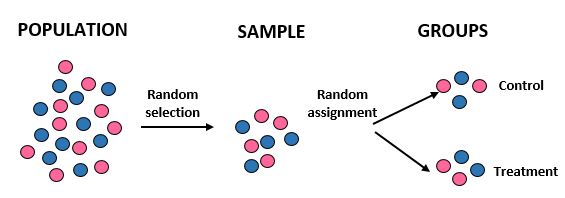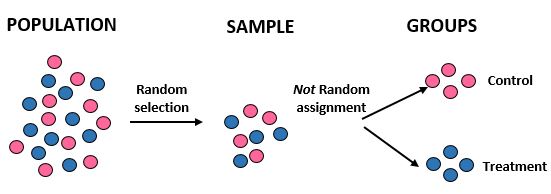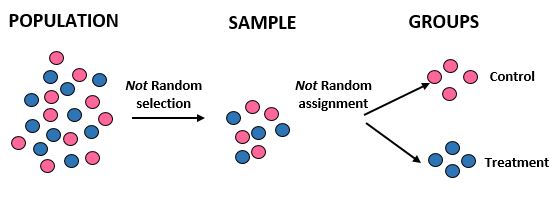Random selection and random assignment are two techniques in statistics that are commonly used, but are commonly confused.
Random selection refers to the process of randomly selecting individuals from a population to be involved in a study.
Random assignment refers to the process of randomly assigning the individuals in a study to either a treatment group or a control group.
You can think of random selection as the process you use to “get” the individuals in a study and you can think of random assignment as what you “do” with those individuals once they’re selected to be part of the study.
The Importance of Random Selection and Random Assignment
When a study uses random selection, it selects individuals from a population using some random process. For example, if some population has 1,000 individuals then we might use a computer to randomly select 100 of those individuals from a database. This means that each individual is equally likely to be selected to be part of the study, which increases the chances that we will obtain a representative sample – a sample that has similar characteristics to the overall population.
By using a representative sample in our study, we’re able to generalize the findings of our study to the population. In statistical terms, this is referred to as having external validity – it’s valid to externalize our findings to the overall population.
When a study uses random assignment, it randomly assigns individuals to either a treatment group or a control group. For example, if we have 100 individuals in a study then we might use a random number generator to randomly assign 50 individuals to a control group and 50 individuals to a treatment group.
By using random assignment, we increase the chances that the two groups will have roughly similar characteristics, which means that any difference we observe between the two groups can be attributed to the treatment. This means the study has internal validity – it’s valid to attribute any differences between the groups to the treatment itself as opposed to differences between the individuals in the groups.
Examples of Random Selection and Random Assignment
It’s possible for a study to use both random selection and random assignment, or just one of these techniques, or neither technique. A strong study is one that uses both techniques.
The following examples show how a study could use both, one, or neither of these techniques, along with the effects of doing so.
Example 1: Using both Random Selection and Random Assignment
Study: Researchers want to know whether a new diet leads to more weight loss than a standard diet in a certain community of 10,000 people. They recruit 100 individuals to be in the study by using a computer to randomly select 100 names from a database. Once they have the 100 individuals, they once again use a computer to randomly assign 50 of the individuals to a control group (e.g. stick with their standard diet) and 50 individuals to a treatment group (e.g. follow the new diet). They record the total weight loss of each individual after one month.

Results: The researchers used random selection to obtain their sample and random assignment when putting individuals in either a treatment or control group. By doing so, they’re able to generalize the findings from the study to the overall population and they’re able to attribute any differences in average weight loss between the two groups to the new diet.
Example 2: Using only Random Selection
Study: Researchers want to know whether a new diet leads to more weight loss than a standard diet in a certain community of 10,000 people. They recruit 100 individuals to be in the study by using a computer to randomly select 100 names from a database. However, they decide to assign individuals to groups based solely on gender. Females are assigned to the control group and males are assigned to the treatment group. They record the total weight loss of each individual after one month.

Results: The researchers used random selection to obtain their sample, but they did not use random assignment when putting individuals in either a treatment or control group. Instead, they used a specific factor – gender – to decide which group to assign individuals to. By doing this, they’re able to generalize the findings from the study to the overall population but they are not able to attribute any differences in average weight loss between the two groups to the new diet. The internal validity of the study has been compromised because the difference in weight loss could actually just be due to gender, rather than the new diet.
Example 3: Using only Random Assignment
Study: Researchers want to know whether a new diet leads to more weight loss than a standard diet in a certain community of 10,000 people. They recruit 100 males athletes to be in the study. Then, they use a computer program to randomly assign 50 of the male athletes to a control group and 50 to the treatment group. They record the total weight loss of each individual after one month.

Results: The researchers did not use random selection to obtain their sample since they specifically chose 100 male athletes. Because of this, their sample is not representative of the overall population so their external validity is compromised – they will not be able to generalize the findings from the study to the overall population. However, they did use random assignment, which means they can attribute any difference in weight loss to the new diet.
Example 4: Using Neither Technique
Study: Researchers want to know whether a new diet leads to more weight loss than a standard diet in a certain community of 10,000 people. They recruit 50 males athletes and 50 female athletes to be in the study. Then, they assign all of the female athletes to the control group and all of the male athletes to the treatment group. They record the total weight loss of each individual after one month.

Results: The researchers did not use random selection to obtain their sample since they specifically chose 100 athletes. Because of this, their sample is not representative of the overall population so their external validity is compromised – they will not be able to generalize the findings from the study to the overall population. Also, they split individuals into groups based on gender rather than using random assignment, which means their internal validity is also compromised – differences in weight loss might be due to gender rather than the diet.